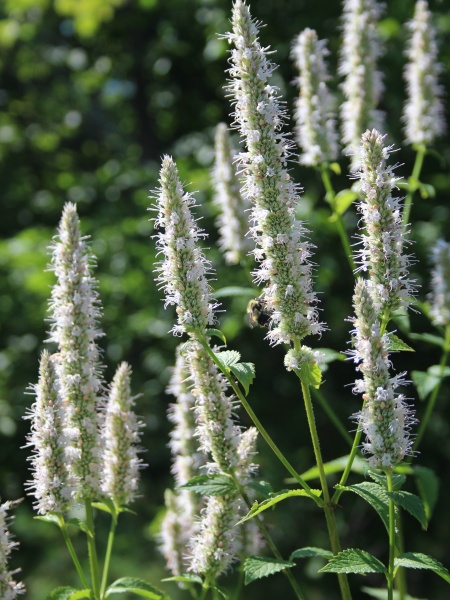Notice: We do not accept seeds that were given before 2025 as they had hybridized with Korean mint.

Source: OWSL
Agastache scrophulariifolia
Purple Giant Hyssop
Agastache à feuilles de scrofulaire
Synonyms
figwort giant-hyssop
Seeds in stock
Available at table Mixed Sun, Medium
Available at table Mixed Sun, Medium
We currently accept seeds for this plant
Bloom Colour: Purple
Bloom Period: Jul - Oct
Max Height: 6.0 feet
Max Width: 2.0 feet (spreads by rhizome)
Light Condition:
 More than 6 hours of direct sun a day
More than 6 hours of direct sun a day
 More than 2 or 3 hours but less than 6 hours of direct sun a day
Soil conditions:
More than 2 or 3 hours but less than 6 hours of direct sun a day
Soil conditions:
 Tolerates medium soil condition
Tolerates medium soil condition
 More than 6 hours of direct sun a day
More than 6 hours of direct sun a day
 More than 2 or 3 hours but less than 6 hours of direct sun a day
More than 2 or 3 hours but less than 6 hours of direct sun a day
 Tolerates medium soil condition
Tolerates medium soil condition
Lifespan:
Perennial
plants that will that come back year after year
Gardener Experience:
 Suitable for beginner gardeners
Suitable for beginner gardeners
 Easy to germinate
Easy to germinate
 Self-seeding
Self-seeding
 Suitable for beginner gardeners
Suitable for beginner gardeners
 Easy to germinate
Easy to germinate
 Self-seeding
Self-seeding
Landscape Uses:
 Suitable for container garden
Suitable for container garden
 Suitable for school gardens
Suitable for school gardens
 Suitable for container garden
Suitable for container garden
 Suitable for school gardens
Suitable for school gardens
Ecological Benefits:
 Supports hummingbirds
Supports hummingbirds
 Supports birds
Supports birds
 Butterfly host
Butterfly host
 Supports hummingbirds
Supports hummingbirds
 Supports birds
Supports birds
 Butterfly host
Butterfly host
Tolerates:
 Tolerates drought conditions
Tolerates drought conditions
 Deer resistant
Deer resistant
 Rabbit resistant
Rabbit resistant
 Tolerates limestone conditions
Tolerates limestone conditions
 Tolerates transplantation
Tolerates transplantation
 Tolerates drought conditions
Tolerates drought conditions
 Deer resistant
Deer resistant
 Rabbit resistant
Rabbit resistant
 Tolerates limestone conditions
Tolerates limestone conditions
 Tolerates transplantation
Tolerates transplantation
Special Features and Considerations:
 This plant is endangered
This plant is endangered
 This plant is septic tank safe
This plant is septic tank safe
 This plant is endangered
This plant is endangered
 This plant is septic tank safe
This plant is septic tank safe
Plant Location
Distribution according to VASCAN

Ephemeral
Native
Introduced
Excluded
Extirpated
Doubtful
Absent
Thrives in Ecozones
- Mixed Wood Plains
Ecological Benefits
Butterflies Supported by Agastache scrophulariifolia
No butterfly data available for this plant.
Specialized Bees Supported by Agastache scrophulariifolia
No bee data available for this plant.
Plants that grow in similar conditions, that bloom at the same time.
Complementary Plants
- Amorpha canescens
Leadplant
Faux-indigo blanchissant - Anemone cylindrica
Long-headed Anemone
Anémone cylindrique - Elymus canadensis
Canada Wild Rye
Élyme du Canada - Oenothera gaura
Biennial Gaura
Gaura bisannuel - Rudbeckia laciniata
Cut-leaved Coneflower
Rudbeckie laciniée
Substitute For Non-Native Plants
- Perovskia Atriplicifolia (Russian Sage)
- Lupinus (Non-Native Lupins)
- Ajuga reptans (Bugleweed)
- Buddleia (Butterfly Bush)
- Delphinium (Delphinium)
- Salvia (Non-Native Sage)
- Lavandula (Lavender)
Sowing Information
Download Seed Envelope Labels (PDF)
- Sowing depth: Surface sow
- Sow by February
- Stratification duration: 60 days
- Self-seeding
Harvesting and Seed Sharing
- Harvest start month: October
- Harvesting indicator:
- Pods are brown and crisp and starting to open
- Seeds are dark and tiny stem attaching to the main stem is brown
- Seeds easily fall off pod when shaken
- Little stem connecting the pod to the main stem is brown (not green)
- Harvesting:
- Put pods in food processor or blender and blend seeds, and strain seeds using a strainer
- Seed viability test:
- No test needed before donating
- Packaging measure: Half of one, 1/32 teaspoon
- Seed storage:
- Air dry in paper bag or open container, for a few days until crisp
- Shake seeds to move them once in a while to prevent molding
- Cultivar: Yes, do not donate unless you know source, and there are no known cultivars in your garden or at proximity
- No harvesting video available at this time.
Toxicity Notes
Can cause cats indigestion.


 Canadensis
Canadensis
